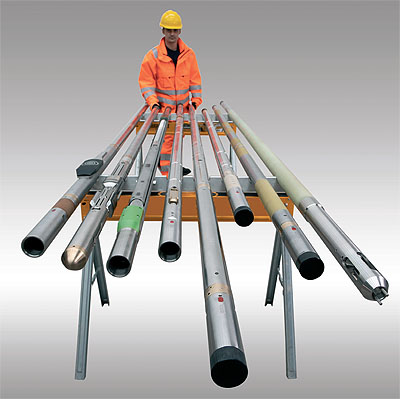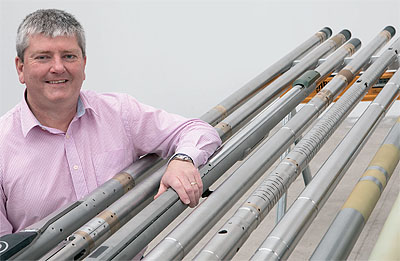Robertson Geo
A pioneering approach
Robertson Geo (RG), formally Robertson Geologging, officially came into being in 1979 via the activities of Robertson Research. It was the latter business that utilised its experience in applying geological interpretation technology to the quarrying industry to take its first steps into the world of North Sea oil and gas in the late 1960s, and helped give RG the platform to pioneer the  development of slim-hole digital borehole logging systems and techniques.
development of slim-hole digital borehole logging systems and techniques.
During the 1980s, RG successfully designed a suite of digital logging tools from the ground up specifically for in-house use. The tools were especially unique in that they became the first to be used outside of the oil and gas market, where analogue equivalents had until then been the norm. However, it was not until 1986, following a crash in oil prices and the rapid decline of the coal industry in the UK, which was a key source of revenue at the time, that a major change occurred within the business with RG being sold off following a management buyout. This was the catalyst for the business to move from being purely a manufacturer and user of its own technology, into one that developed comprehensive sales and service functions and sold its technologies globally.
Fast forward to 2018 and RG, under the majority ownership of the OYO Corporation of Japan, is the largest global supplier of slim-hole logging equipment, supplying well-logging instrumentation and logging services to over 160 countries and on every continent. Industries served not only include oil and gas and mining, but also nuclear and civil engineering, geotechnical, water-well management and the renewables sector. Headquartered in Deganwy, North Wales, it also has subsidiary companies in Hong Kong supporting the Asia-Pacific region, and the United States that directly supports the North and South American markets, while a network of local agents and representatives provides support elsewhere.
Business advantages
The global presence of the company not only means that its solutions and services have been put to great use in a number of well publicised domestic projects in the UK, such as the A303 Stonehenge construction, HS2, Crossrail, Lower Thames crossing, Hinkley Point C and all of the major offshore wind farms, but also in a number of far-flung, challenging locations such as Greenland, Antarctica and even on Mount Everest.
“The core business of the company today continues to revolve around our range of geophysical logging technologies,” explains RG’s Managing Director, Simon Garantini. “As well as solidifying our position in a number of different market sectors, we have also differentiated ourselves through the efforts of our Services division. Thanks to our breadth of experience and the support of our manufacturing and development teams, we are able to offer a range of services at short notice, for projects both onshore and offshore, which is a capability that clients within the offshore industry in particular appreciate.
“We are also the only company of our kind to be ISO certified, which gives us a modern-day advantage as we run all of our processes through an ISO risk management framework that underpins our quality management system. Additionally, we are the only company to possess its own test well on site. This means that once our tools are developed, again on site, and tested using the full calibration capabilities that we have in-house, we can put them to use in our test well to analyse their performance against tens of thousands of runs of similar products held around the world to ensure that we have the optimum end product in front of us.”
New technologies
Simon himself was brought into the business by OYO Corporation during 2017 as part of what he calls a ‘reactivation’ of RG, and his first few months in the role allowed him the opportunity to study the main strengths and qualities that have enabled RG to prosper. “Looking back over the history of the business, it is clear that it has always been a pioneer and an innovator in its area of expertise,” he details. “In developing a range of digital tools and partnering this with a can-do attitude, it brought about a step-change in its various market segments, and that is something we want to unlock the value of further in the years to come.”
In April 2018, Simon oversaw the formal rebranding of the business as it moved away from its previous Robertson Geologging moniker, which he admits was somewhat pigeon-holing it, and with this came the start of a concentrated marketing push that he anticipates will run for the next two years before fully established. “What has begun with establishing our new registered trademarks and corporate brand will soon be accompanied by the launch of an innovative marketing and promotional platform; these are exciting times for our company,” he said. “At the same time, we are working to develop a business development plan to energise the sales and marketing sides of the business in anticipation for what 2019 holds.”
What next year is set to bring is the result of a project to completely redesign RG’s core technologies. Dubbed Project Agile, Simon believes it will be key to revolutionising the company and putting it back into a position of technology leadership. “We have taken everything that RG has learnt and perfected over its 40-years of existence and funnelled that into what will be a completely new range of technologies and systems that will provide further proof of RG’s ability to respond to our customers’ needs,” he proclaims. “We are confident that this, coupled with a concentrated marketing push, will bring the business back to where it was historically and that is into a position of being a technology leader, as well as being the default choice for customers seeking innovative, reliable logging systems that are born from 40 years of experience and know-how.”
Robertson Geo
Products: Slim-hole geophysical logging equipment across five market segments: oil & gas, mining & minerals, renewables, water & environmental and geotechnical, backed by a service division